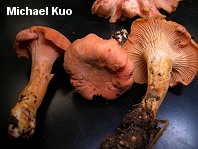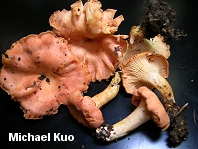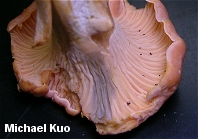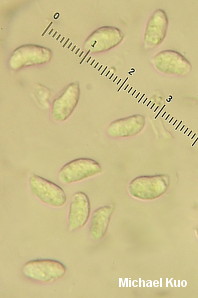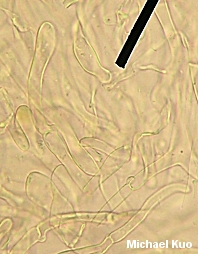| Major Groups > Chanterelles and Trumpets > Cantharellus persicinus |

|
Cantharellus persicinus [ Basidiomycota > Cantharellales > Cantharellaceae > Cantharellus . . . ] by Michael Kuo This fascinating chanterelle appears to be limited to the Appalachian Mountains, where it is relatively infrequently encountered--usually in association with oaks or eastern hemlock. Cantharellus persicinus is a medium-sized species that seems to differ from other Cantharellus cibarius-like species primarily in its color; rather than the egg-yolk yellow to orange-yellow colors found in most of the cibarius-like species, Cantharellus persicinus is a gorgeous pinkish peach color. But more than a mere color difference is involved. DNA studies that have tested Cantharellus persicinus (Dunham et al., 2003; Moncalvo et al., 2006) not only support recognizing it as a distinct species; it appears to be well separated from Cantharellus cibarius, and may even represent one of the "basal" lineages from which many of the cibarius-like species evolved. Description: Ecology: Mycorrhizal with oaks or eastern hemlock; growing alone or gregariously; summer and fall; Appalachian Mountains. The illustrated collection is from Ohio. Cap: 2-5 cm wide; convex, becoming broadly convex or nearly flat; hoary when young, becoming very finely roughened, or nearly bald; dry; the margin inrolled when young, becoming wavy or irregular with maturity; salmon-orange to pinkish orange (peach colored); the margin bruising and discoloring yellowish. Undersurface: With well developed, blunt false gills that run down the stem; sometimes developing cross-veins; colored like the cap or paler. Stem: 2-5 cm long; 0.5-1.5 cm thick; tapered to base; bald; colored like the cap, with a whitish base; bruising and discoloring yellowish to brownish yellow. Flesh: Whitish; solid; unchanging. Odor and Taste: Taste mild; odor mild or sweet and fruity. Chemical Reactions: Iron salts gray on undersurface. Spore Print: Whitish to pinkish. Microscopic Features: Spores 7-10 x 4-5 µ; smooth; ellipsoid; ochraceous in KOH; with minutely granular contents. Basidia 65-80 µ long; 4-sterigmate. Terminal cells on cap surface 2-10 µ wide; hyaline to ochraceous in KOH; clamped; subclavate to clavate or merely cylindric with rounded apices; thin- or thick-walled. REFERENCES: Petersen, 1986. (Petersen, 1986; Roody, 2003; Buyck et al., 2011.) Herb. Kuo 07171006. This site contains no information about the edibility or toxicity of mushrooms. |
© MushroomExpert.Com |
|
Cite this page as: Kuo, M. (2015, March). Cantharellus persicinus. Retrieved from the MushroomExpert.Com Web site: http://www.mushroomexpert.com/cantharellus_persicinus.html |
